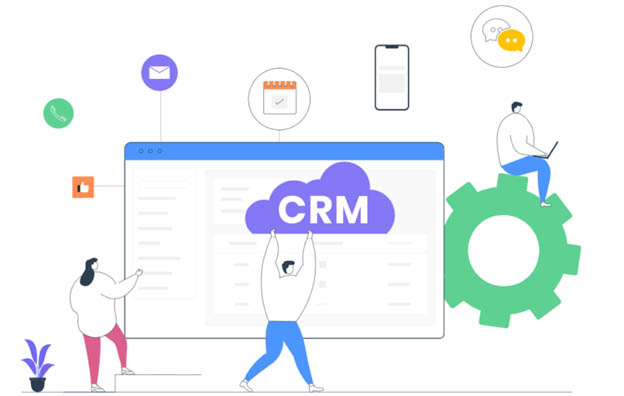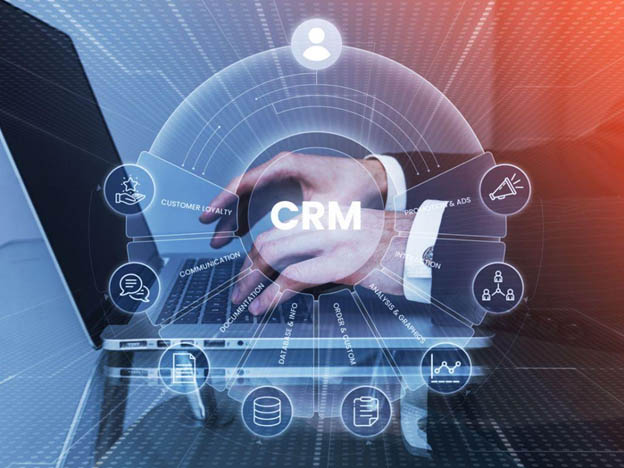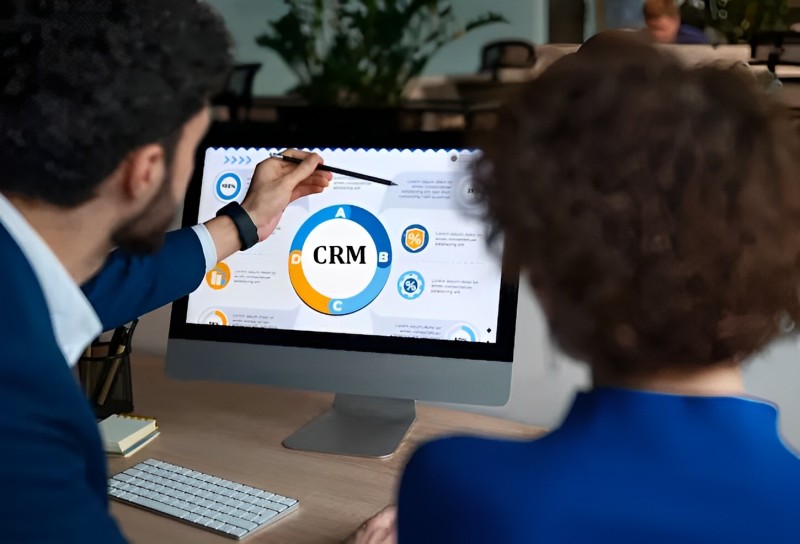
Image Source – https://www.vtiger.com/
CRM software serves as the foundation of successful sales and marketing operations in modern businesses.
As the market continues evolving rapidly, implementing the right Dynamics CRM Solutions India and testing strategy can determine which companies sink or swim.
Testing and optimization is not a one-and-done project but rather an iterative process as needs shift.
Whether targeting increased sales productivity, improved visibility, or enhanced customer experiences, CRM configuration testing strategies are mission-critical.
Let us explore Key drivers and latest trends in the CRM software market, Top reasons why CRM testing fails and how to avoid pitfalls, mapping testing methods to business objectives, Real-world examples and use cases of successful CRM adoption, and Key questions to ask you’re testing and optimization journey
CRM Market Landscape: Forces Driving Demand

Image Source – https://www.edgecrm.app/
The CRM software market is projected to grow rapidly through 2030 as more organizations prioritize customer-centricity. Some trends fueling this rapid growth include:
- Migration to the Cloud – Cloud-based CRM solutions now dominate new license deals as companies seek lower total cost of ownership (TCO), flexibility, scalability, and mobility. Leading SaaS platforms like Salesforce and Microsoft Dynamics 365 CRM compete intensely for market share.
- Need for Centralized Data – By consolidating customer data and interactions in one CRM platform, sales and marketing teams gain a “single source of truth” to inform smarter decisions.
- Emerging Technologies – Artificial intelligence, predictive analytics, customer journey orchestration, and other innovations help uncover new CRM use cases and revenue opportunities. Voice, blockchain, and augmented reality integration are also on the horizon.
- Economic Shifts – Both the pandemic and potential future downturns have led executive teams to prioritize revenue retention and customer loyalty through modern CRM strategies.
With so much potential value on the line, the stakes could not be higher for organizations selecting and configuring their CRM systems.
Even industry leaders using CRM for over 20 years still fine-tune their platforms continually. So what testing approaches set the stage for long-term market dominance?
Why CRM Testing Fails – And How to Avoid Pitfalls
Simply installing a CRM without a clear testing methodology leads many transformation efforts astray.
Some common pitfalls to avoid include:
- No Executive Buy-In – CRM testing cannot be delegated fully to IT teams. Senior leadership must evangelize usage and link CRM data to strategic goals.
- Lack of Change Management – Insufficient communication and training during and after CRM rollouts confuse reducing user adoption. Employees should understand what’s in it for them.
- Design Misalignment – Sales and marketing teams often complain new CRMs don’t reflect how they need to work. Requirements gathering and design testing are crucial.
- Data Errors – Bad or incomplete legacy customer data migrated to new CRMs severely impacts reporting and analytics if not tested thoroughly.
- Customization Creep – Over-customizing platforms to match old workflows can reduce ROI significantly long term by increasing TCO for upgrades, integrations, and training.
By prioritizing executive sponsorship, change management, and a phased test-and-learn approach, organizations can mitigate these pitfalls on their journey to CRM success.
CRM Testing Methods Mapped to Business Goals
Approaching CRM testing without clear business objectives wastes precious IT resources and has little impact.
To help guide priorities, here is an overview of popular CRM testing methods mapped to common organizational goals:
Increase Sales Productivity
Testing Focus: Usability, Adoption, Performance
Example Tactics:
- Pilot platform with sales team for user feedback
- Compare sales metrics before/after (calls, meetings booked)
- Gather input to improve navigation, reporting, and workflows
Improve Marketing Campaign Performance
Testing Focus: Integrations, Analytics, Attribution
Example Tactics:
- Validate data flows from MAPs like email and ads
- Review campaign analytics for data accuracy
- Tune lead scoring rules and nurturing paths
Enhance Customer Experience
Testing Focus: Omnichannel, Self-Service, Field Service
Example Tactics:
- Gather voice-of-customer feedback pre/post-implementation
- Benchmark CSAT or NPS scores vs. targets
- Observe field reps using new mobile capabilities
Increase Customer Lifetime Value
Testing Focus: Account Management, Loyalty/Referral Programs
Example Tactics:
- Audit account plans and engagement data
- Review adoption levels of referral tools
- Check cross-sell/upsell report accuracy
While the above testing frameworks provide helpful guidelines, each organization’s CRM requirements remain unique.
The best approach involves cross-functional collaboration across IT, sales, marketing, and CX teams while keeping the end business objectives at the core.
Optimizing Workflows for Evolving Business Needs

Image Source – https://quixy.com/
Even after initial CRM testing wraps up, the optimization journey never truly ends. As strategies shift and new technologies emerge, workflows must adapt in kind.
Here are tips for maintaining alignment:
- Schedule quarterly check-ins – Gather department heads to discuss upcoming initiatives on the roadmap that may impact platform configuration
- Monitor adoption metrics – Usage data, help desk ticket analysis, and user surveys reveal where processes are breaking or friction points emerge
- Prioritize enhancements that bridge gaps – If sales teams switch to consultative selling, they may need a new proposal workflow. Update configurations to match reality.
- Balance customizations with flexibility – Over-customizing CRM to match legacy tools can limit agility long-term and increase TCO. Keep this risk in mind.
- Explore new functionality early – Stay on top of the latest platform innovations and how peers are leveraging them. Be among the first to pilot new capabilities.
With open cross-functional communication channels and a test-and-learn mindset focused on maximizing customer and employee value, organizations can keep their CRM strategies fresh.
CRM Security and Compliance Considerations
With expanding consumer data privacy regulations and cyber threats, protecting customer information is paramount during testing cycles and beyond:
- Establish data governance early – Classify all data types and sensitivity levels. Set policies for retention, access permissions, and third-party sharing.
- Assess default platform security controls and adjust as needed – Multi-factor authentication, endpoint monitoring tools, and role-based access levels help harden CRM environments.
- Validate integrations with other databases – Ensure seamless data flows don’t create security loopholes. Check for errors or incomplete customer records.
- Model potential breach scenarios – Simulate phishing attacks against internal users and denial-of-service disruptions to uncover potential contingency plan gaps.
- Monitor audit logs regularly – Tools like change data capture can alert admins of suspicious permission or configuration changes for investigation.
While cyber risks can never be fully eliminated, taking proactive measures to lock down infrastructure and test crisis response processes gives organizations confidence in their CRM resilience.
Reporting Strategies to Operate CRM Insights
The most robust CRM has hidden insights that can alter sales, marketing, and customer experience, but only if properly uncovered via reporting tools. Some of the recommended practices are:
- Maintain a living library of reports and dashboards – Categorize by sales, services, and finance use cases to cover all stakeholder needs on a single platform
- Build reports for all key business processes – opportunity pipeline health, campaign ROI, field service productivity, etc.
- Layer in advanced analytics – machine learning algorithms help discover correlations and predictive drivers buried deep in CRM data.
- Deliver insights through preferred channels – interactive portals, automated alerts, or even conversational chatbot assistants.
- Enforce data literacy across teams – train everyone to glean intelligence from reports rather than just run them. Interpretation skills separate experts.
With the right reporting toolkit and skills development, CRM data can continuously uncover ways to improve customer experiences, employee workflows, and financial performance.
Effective Software Testing Services Provider allows you to identify and resolve potential issues before they impact users.
Getting Executive Buy-In for CRM Testing
Securing leadership alignment is mission-critical for impactful CRM testing.
Without executive buy-in, adoption efforts often fizzle as teams won’t take the initiative seriously.
As a first step, quantify the potential benefits through data-driven business cases:
- Calculate expected ROI – Compare costs of thorough testing and change management vs. the lift in customer retention, the share of wallet, lifetime value, and revenue expansion over 3-5 years model.
- Highlight competitive advantage – Share examples of digital leaders outpacing laggards by leveraging customer data and insights to personalize engagement
- Link to strategic vision – Whether boosting sales productivity or improving CX, illustrate how CRM testing maps to corporate priorities
Next, identify internal CRM testing champions at the executive level. Consistent messaging matters:
- Arrange briefings on CRM best practices – especially for executives lacking first-hand experience leveraging customer data
- Align on core objectives and guiding principles for configuration decisions – i.e. is this change better for sales teams or customers long-term?
- Co-present findings company-wide – have both IT and business leaders celebrate quick wins from early CRM testing to build momentum
Finally, incorporate CX metrics into leadership scorecards.
Just as CEOs are accountable for financial results, they should be rewarded for improving NPS or lowering churn.
Building a Customer-Centric Culture
While sales and marketing often “own” CRM tools, a customer-centric culture starts from the top down across every department. Leaders can nurture this in 3 ways:
1) Connect each employee with customer value
- Use authentic consumer voices to enhance CX.
- Recognize excellent team and individual experiences.
Train all new hires on customer journey mapping
2) Break down data silos
- Audit access to customer data – who can view what?
- Explore cross-functional KPIs beyond departmental metrics
- Demonstrate how teams can leverage CRM data in their roles
3) Continually gather external insights
- Voice-of-customer research goes beyond surveys – analyze social media, call transcriptions with speech analytics, and customer communities
- Create grassroots “customer advisory panels”
- Conduct win/loss interviews – why did prospects choose competitors?
This outside-in perspective must permeate CRM testing. The best platforms reflect how customers want to research, purchase from, and engage with your brand.
The People Factor – Training and Support Strategies
No CRM testing plan is complete without addressing the people dimension.
Making such a transformational leap requires thoughtful change management and training at every turn:
- Start with the basics – assess digital literacy skills employees need to thrive and fill any gaps with “CRM 101” Education
- During testing – maintain open dialogue channels gathering user feedback via focus groups and ideation workshops
- At launch – make training engaging with role-play scenarios and gamification vs. boring slide decks whenever possible
Ongoing support resources also ease the transition:
- Create CRM “super users” – identify power platform admins amongst teams to provide peer coaching
- Launch online communities – for employees to discuss use cases, share tips and tricks
- Develop help documentation – user guides, eLearning modules, even AI chatbots to field questions
- Keep surveying adoption – usage metrics demonstrate who is embracing vs. resisting change
The “if you build it they will come” notion rarely applies. CRM testing must factor in the people puzzle – from initial change communications to ongoing capability building.
By prioritizing software testing, you can deliver a seamless user experience that outperforms competitors.
Launching Your CRM Testing Journey
As today’s market leaders have demonstrated, testing early, often, and against clear business goals elevates any CRM from a static database into a dynamic competitive advantage.
As you explore platforms and strategy for your organization, here are some key questions to ask:
What important pain points does our sales/marketing team require CRM to address? How will we ensure that it does this?
Which systems and datasets need integration for a 360-degree customer view? How will we validate data flows?
What specific KPIs will what specific KPIs will we track pre and post-launch to measure CRM impact?
Some examples include
- Sales productivity metrics – call volume, meetings booked, pipeline created
- Marketing campaign indicators include click-through rates, cost per lead, and conversion rates.
- Customer service metrics: resolution of case times, customer satisfaction (CSAT) scores.
- Financial metrics: lower software costs, and increased customer lifetime value.
The correct KPIs will link CRM testing to overall business goals such as efficiency, revenue growth, and customer retention.
Finally, how will we course-correct based on test findings? Building a culture and governance model for ongoing optimization is critical.
Assign CRM owners across sales, marketing, CX, and IT to continually gather user feedback, reassess needs, and scope improvement projects.
While launching a new CRM takes heavy lifting, maintaining momentum with iterative testing and enhancement initiatives determines whether your investment pays continuous dividends.
With the right testing rigor and business alignment, your organization can build customer connections that drive growth for years to come.
What questions are still on your mind? Which metrics or use cases are you most keen to test in your CRM rollout?
We welcome any additional thoughts as you shape your customer-centric technology strategy.



